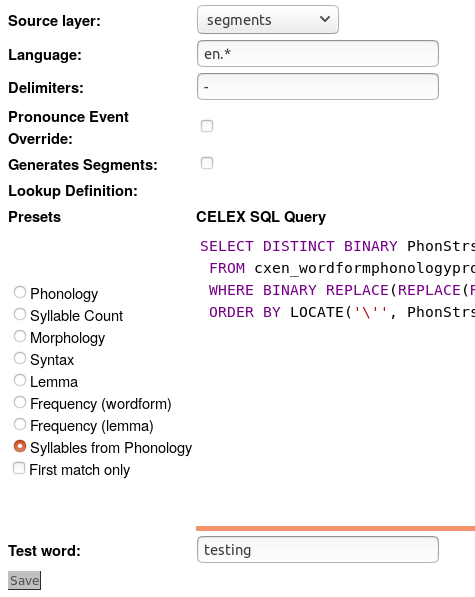Syllables and Stress
This page describes how to generate stress-marked syllable annotations after forced alignment, which can be achieved if your original poronunciation dictionary includes syllable/stress marking (e.g. CELEX and Unisyn do, but the CMU Pronouncing Dictionary doesn’t).
What LaBB-CAT does is:
- Take the phonemic transcription of each word from the segment layer (e.g. the one chosen by HTK during forced alignment), which has no syllable or stress marks.
- Look it up in CELEX.
- If it’s found, it takes the syllable/stress-marked version of the phonemic transcription
- It splits the transcription into syllables, and creates an annotation for each syllable that spans the corresponding phones on the segment layer.
Once you have such annotations, it’s much easier to identify, for example, specific vowels but in stressed syllables only.
Prerequisites
- A layer that tags each word token with its phonemic transcription according to CELEX or a Unisyn lexicon.
- Force-alignment using the above phonemic transcription layer, so you have a segments layer filled in with aligned phones.
NB: If phone alignments are produced by a different dictionary, then the resulting phonemic transcriptions will not match the dictionary and so syllables cannot be reconstructed. e.g. if you use the MFA built-in English dictionary, with MFA’s pretrained acoustic models, reconstructing syllables from CELEX transcriptions will fail.
Steps
- In LaBB-CAT, click the word layers menu option
- At the top of the list of word layers, fill in the blank header form in order to add a new layer. Important points are:
- Type = Phonological
- Alignment = Intervals
- Manager = CELEX English

- Press New. You will bee taken to the layer configuration page.
- On the left, select the Syllables from Phonology option.
This will automatically set Source Layer to segments and Delimiters to-(hyphen)

- Press Save
- Pres Regenerate
You will see a progress bar as LaBB-CAT processes all the transcripts in the database. This processing is done in the background, you don’t need to wait until it’s finished before visiting other pages.
Once the layer annotations are generated, each word that has been previously force-aligned will now have one or more syllable annotations, marking out the phones that belong to each syllable.
The label of each syllable annotation is the stress-marked phonemic transcription of the syllable, so for syllables with primary stress, the first character in the label is ’ (an apostrophe), and those with secondary stress have ” (double-quote) as the first character.

Now, if you want to, for example, identify all kit vowels in syllables with primary stress only, you can do a search:
- for segments labelled as the kit vowel
- whose syllable starts with the primary stress mark
'
